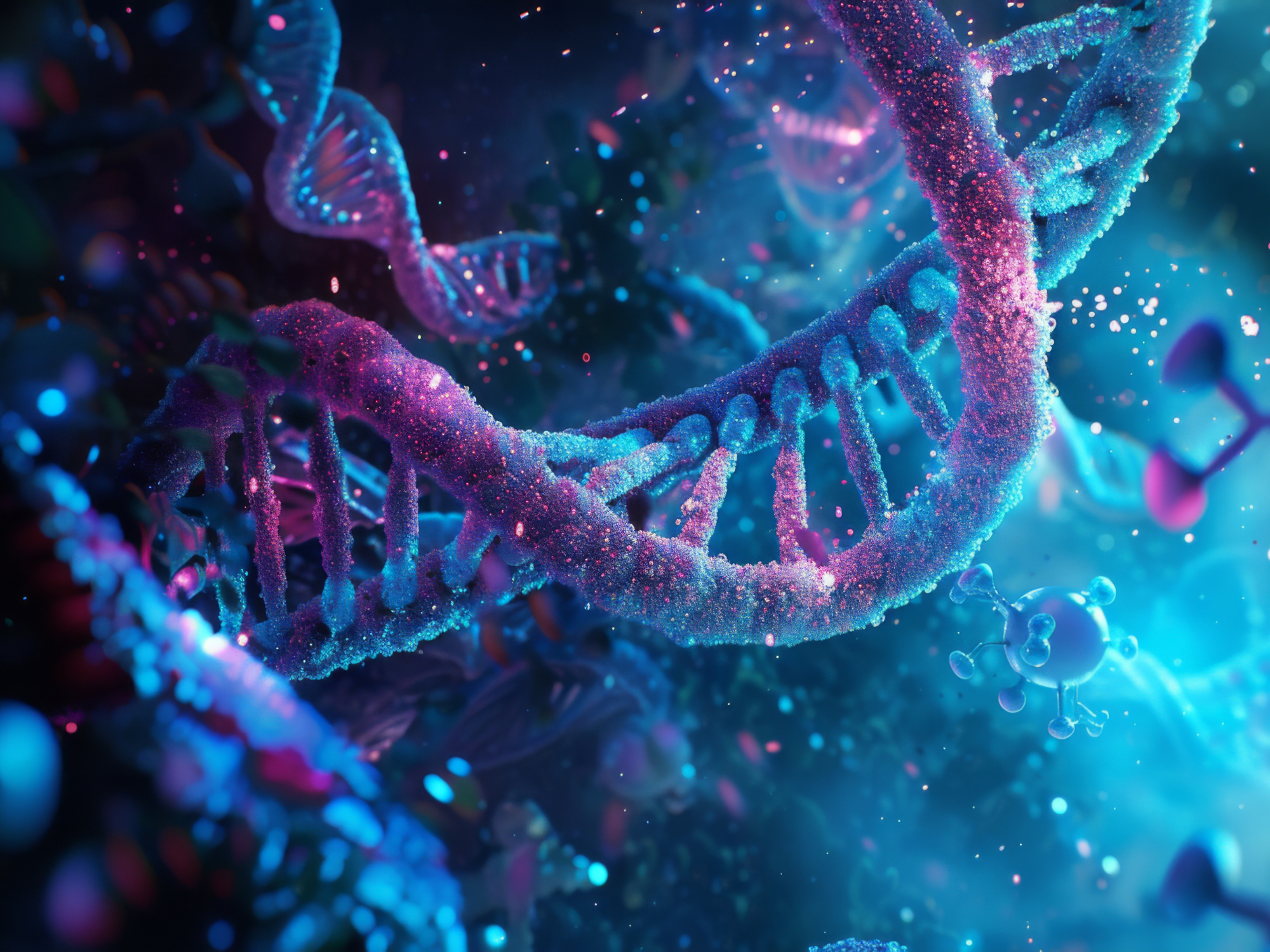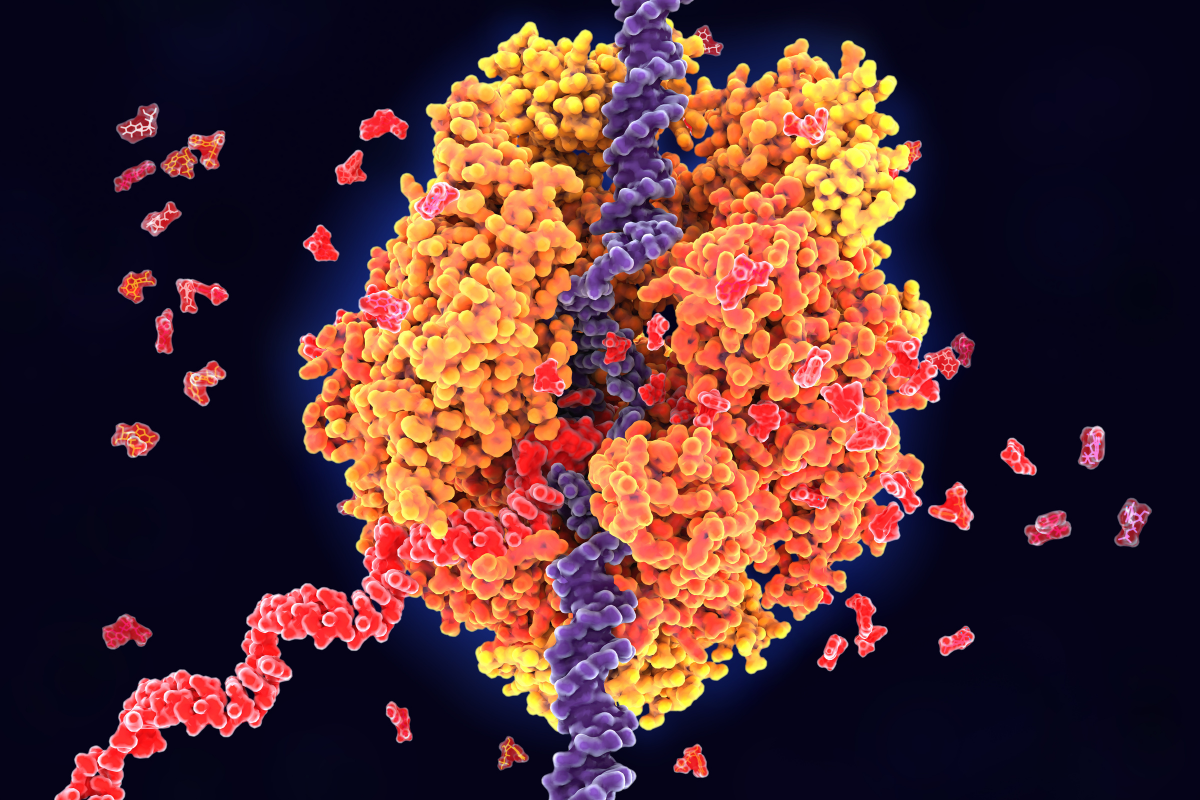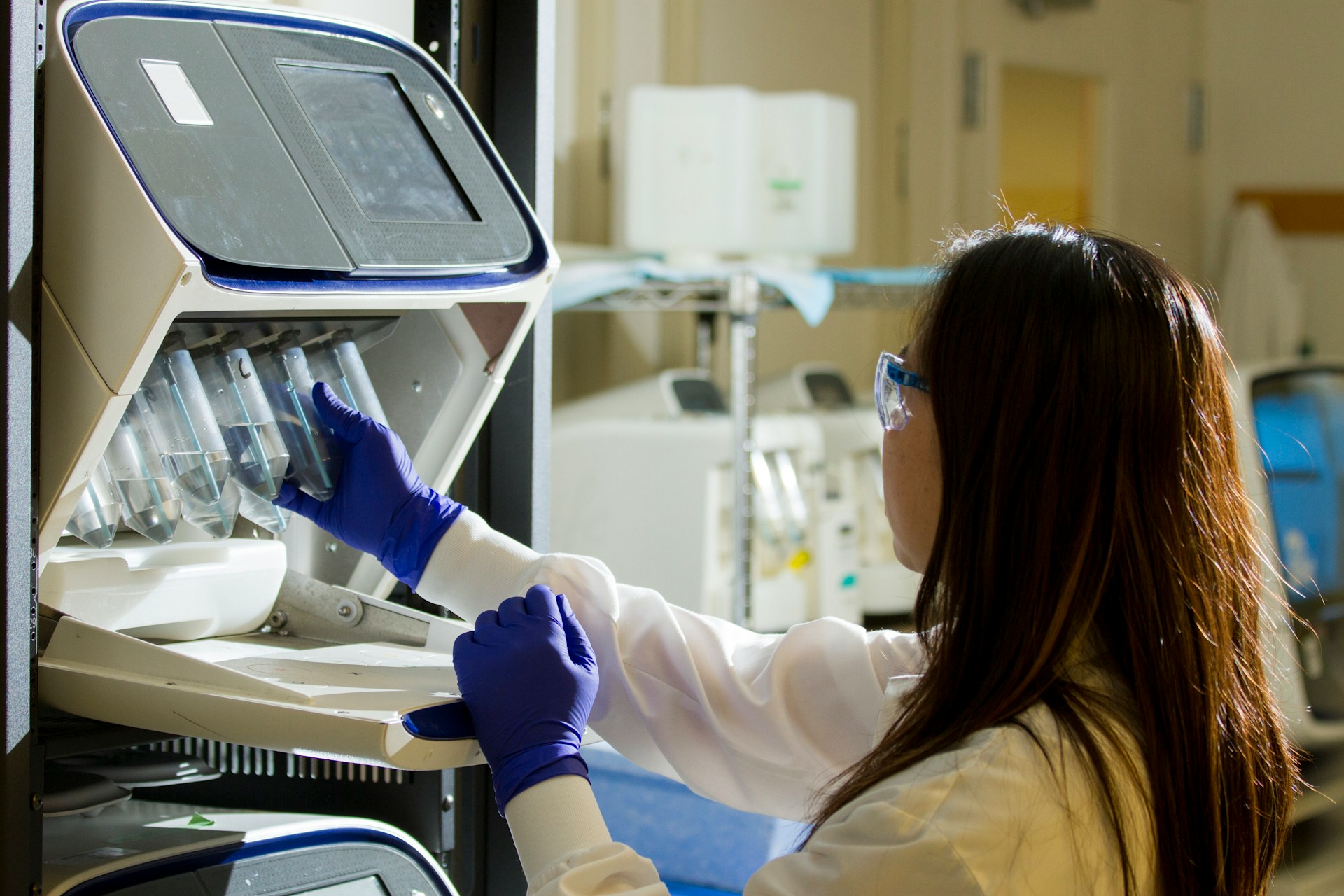Refractive Index Paves the Way to Greener Peptide and Oligonucleotide Synthesis

Peptide and oligonucleotide synthesis are crucial processes in biotechnology and medicine, enabling the development of a wide range of innovative drugs and therapies. However, the sustainability of these processes is a growing concern, particularly in light of the increasing demand for these molecules and their potential impact on the environment.
One major issue is the waste generated during synthesis, including solvents, reagents, and other harmful chemicals to human health and the environment. To address these challenges, researchers are exploring new synthetic methodologies that are more efficient, less toxic, and less wasteful.
John Lopez, Solid Phase Peptide Synthesis Expert at Novartis, is one of many exploring new avenues for more sustainable solid-phase peptide and oligonucleotide synthesis (SPPS and SPOS, respectively). Presenting at Oxford Global’s Sustainable Chemistry 2023 event, Lopez discussed how measuring the refractive index of solutions during peptide and oligonucleotide synthesis could render these processes more sustainable.
The Refractive Index: How It Works
The refractive index (RI) measures the change in the speed of light as it passes through a material. More specifically, it measures the deviation of light when passing between media due to different optical densities. This deviation occurs because it is harder for light to travel through a solution if there is more dissolved material.
It is an important physical property measured in various disciplines, including optics, materials science, and chemistry. In the food and beverage industry, one common application of the RI is to measure the sugar content of drinks. RI is directly proportional to sugar content, as it is harder for light to travel through a solution if there is more dissolved material - in this case, sugar – in the solution.
Using RI for Molecule Synthesis
Inspired by this use of the RI, Lopez began to investigate whether it could be applied to molecule synthesis. There are many aspects of the peptide and oligo synthesis processes which have substantial room for improvement: many parts of these processes, such as coupling reactions, resin washes, Fmoc clearance, and capping, are highly time-consuming and unsustainable. Moreover, these methods generally provide qualitative data which lacks necessary detail.
Lopez explained that mass transfers in SPPS and SPOS reveal the potential of RI to reveal crucial information about the processes. Fundamentally, as mass transfers occur in each step of the process, the density of the solution changes with each transfer, meaning that the RI must also change. Figure 1 demonstrates this concept specifically in relation to solid-phase peptide synthesis.
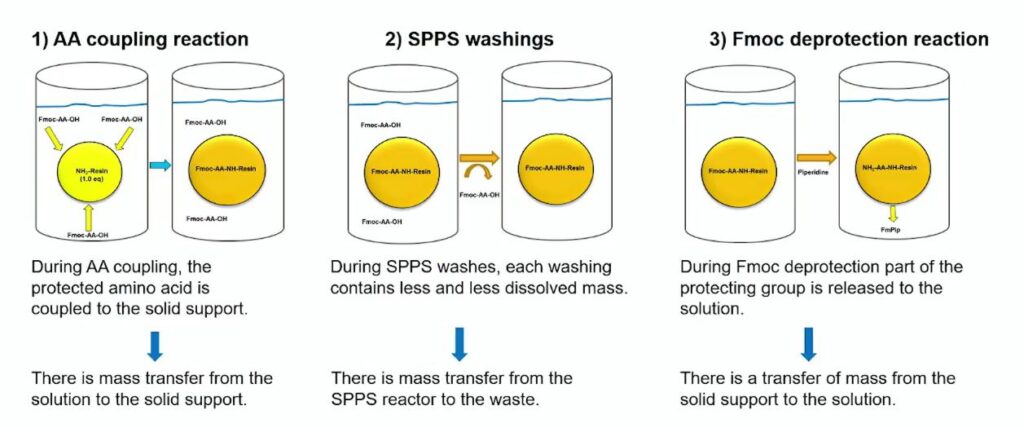
Proof of Concept: RI as a PAT Tool for SPPS and SPOS
Lopez first discussed the experiments he performed in collaboration with Beatriz G. de la Torre and Fernando Albericio from the University of KwaZulu-Natal to assess the viability of RI for SPPS. Firstly, they investigated how RI behaves with different concentrations of amino acids in DMF solutions.
Researchers tested with four different antibodies and established a clear correlation between increasing RI and amino acid concentration. Lopez noted that these findings reflected the sensitivity of RI to changes in the solution. This assessment was extended to the coupling process of SPPS, and researchers could track the decreasing concentration of amino acids as coupling occurred with a high level of precision.
Researchers evaluated the deprotection rate at various piperidine concentrations to assess RI’s utility when monitoring Fmoc clearance. The deprotection rate using piperidine is rapid and typically quite challenging to measure. Using RI allowed researchers to monitor the concentration far more closely than any other method, meaning less piperidine is required.
- The Future of Peptide Chemistry and Sustainability
- Insulin: Recombinant Production, Sustainability, and Chemistry
- Peptide Characterisation Methods and Impurity Detection
The number of washes needed after Fmoc clearance is typically assessed using phenolphthalein. Using RI, as a more diluted piperidine solution can be used thanks to the increased sensitivity of RI monitoring, the wash technique becomes more sustainable because less piperidine requires less solvent.
One significant advantage of using RI during SPPS is that it removes the need to take resin samples during coupling and Fmoc cleavage. Instead, researchers can observe the data as it is recorded by the refractometer and graphed, as RI reflects what is happening in the solution.
As a proof of concept for RI’s applicability to SPPS, Lopez and his team used RI in the synthesis of leu-enkephalin. Figure 2 demonstrates that the researchers could fully graph the resin loading online. These graphs allowed them to assess the kinetics of the solution and how long each step of the process took without requiring any sampling.
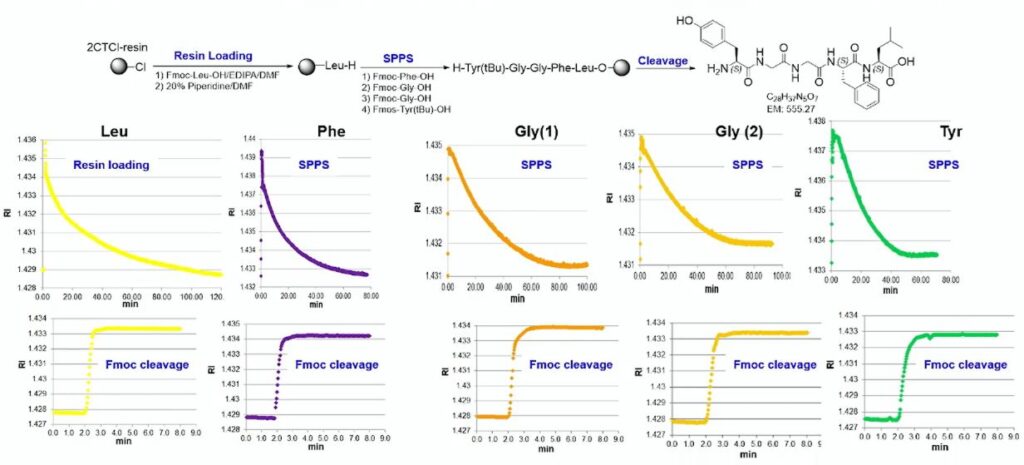
Lopez then described how using RI as a PAT tool for oligonucleotide synthesis is a “natural extension of assessing RI for SPPS” because the processes have many similarities since they involve a deprotection cycle.
Researchers produced several calibration curves for amidites, reagents used for efficient and automated synthesis of nucleic acids. From these curves, they gauged the influence of temperature, molecular weight, concentration, and concentration under coupling conditions. In all these instances, the relationship between refractive index and the variable being investigated was linear. A linear relationship was also established when creating the calibration curve of DMT-cleavage, which Lopez noted was analogous to Fmoc clearance in SPPS.
Once calibration curves had been established, researchers monitored the non-optimised manual synthesis of a trimer using only RI. When the reaction was complete, the analysis of the subsequent compound showed that the desired trimer was represented in the main product with a crude purity of 85%, whilst the two main impurities were two possible deletion side products.
Lopez noted that RI is sensitive enough to detect cleavage of a range of oligonucleotides, from the smallest possible (monomers) up to 21-mers, and that the cleavage support RI provides is complete in just a matter of minutes. He also commented that further development would be necessary to ensure complete couplings in the SPOS process, but overall using RI in this context allows researchers to have more control than previous techniques had permitted.
RI Moving Forwards
Several challenges need to be overcome before RI can be fully integrated into SPPS and SPOS. The refractometers Lopez had custom-made for these experiments were too large, meaning that these prototypes need to be smaller for a development lab.
Another potential drawback to using the refractive index is that it is very susceptible to changes in temperature; Lopez said that "a self-calibrating instrument with software that can complete corrections itself" would be ideal in this context, but currently, this is not on the horizon.
On the other hand, the various opportunities presented by RI undoubtedly warrant further research into this field. RI is a complementary tool with multiple applications in SPPS and SPOS processes. It acts as a universal detector and sensor which can follow mass transfer, whilst also clearly detecting the steady state of a process step. RI is also a PAT tool which removes the need for continual sampling during SPOS and SPPS. Lopez noted that RI is already being used in some commercial peptide synthesisers.
RI also allows researchers to better understand the processes they observe since RI graphs reflect the kinetic profiles of the molecules under observation. Finally, one of the biggest appeals of using RI in SPPS and SPOS is the potential to render these processes more sustainable. Reducing both the cycle times of these procedures and the number of smart resin washes reduces their overall PMI, making RI monitoring a highly promising new methodology in the molecule synthesis space.
Join Oxford Global’s annual Antibody Engineering 2023: Online event today. This intensive 2-day meeting delves into the latest in antibody engineering and antibody-based therapeutics & a meeting place for experts working within engineering, computational tools and antibody-based therapeutics. Download the agenda to join prominent leaders and scientists as they share new case studies, innovative data, and exciting industry outlooks.






